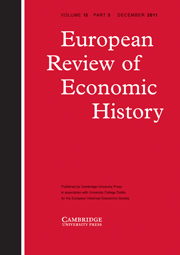Crossref Citations
This article has been cited by the following publications. This list is generated based on data provided by
Crossref.
SCHILTZ, MICHAEL
2012.
Money on the road to empire: Japan's adoption of gold monometallism, 1873–971.
The Economic History Review,
Vol. 65,
Issue. 3,
p.
1147.
Martín-Aceña, Pablo
Martínez-Ruiz, Elena
and
Nogues-Marco, Pilar
2012.
The Gold Standard Peripheries.
p.
145.
Ugolini, S.
2012.
The origins of foreign exchange policy: the National Bank of Belgium and the quest for monetary independence in the 1850s.
European Review of Economic History,
Vol. 16,
Issue. 1,
p.
51.
BURDEKIN, RICHARD C.K.
MITCHENER, KRIS JAMES
and
WEIDENMIER, MARC D.
2012.
Irving Fisher and Price‐Level Targeting in Austria: Was Silver the Answer?.
Journal of Money, Credit and Banking,
Vol. 44,
Issue. 4,
p.
733.
Morys, Matthias
2013.
Discount rate policy under the Classical Gold Standard: Core versus periphery (1870s–1914).
Explorations in Economic History,
Vol. 50,
Issue. 2,
p.
205.
Bazot, Guillaume
Bordo, Michael D.
and
Monnet, Eric
2014.
The Price of Stability. The Balance Sheet Policy of the Banque De France and the Gold Standard (1880-1914)..
SSRN Electronic Journal,
Doskov, Nikolay
and
Swinkels, Laurens
2015.
Empirical evidence on the currency carry trade, 1900–2012.
Journal of International Money and Finance,
Vol. 51,
Issue. ,
p.
370.
Jobst, Clemens
and
Ugolini, Stefano
2016.
Central Banks at a Crossroads.
p.
145.
Eichengreen, Barry
and
Flandreau, Marc
2016.
Central Banks at a Crossroads.
p.
280.
Accominotti, Olivier
and
Chambers, David
2016.
If You're So Smart: John Maynard Keynes and Currency Speculation in the Interwar Years.
The Journal of Economic History,
Vol. 76,
Issue. 2,
p.
342.
Bazot, Guillaume
Bordo, Michael D.
and
Monnet, Eric
2016.
International shocks and the balance sheet of the Bank of France under the classical gold standard.
Explorations in Economic History,
Vol. 62,
Issue. ,
p.
87.
Schenk, Catherine
and
Straumann, Tobias
2016.
Central Banks at a Crossroads.
p.
319.
Ugolini, Stefano
2017.
The Evolution of Central Banking: Theory and History.
p.
207.
Baltussen, Guido
Swinkels, Laurens
and
van Vliet, Pim
2019.
Global Factor Premiums.
SSRN Electronic Journal,
Naef, Alain
2021.
Dirty float or clean intervention? The Bank of England in the foreign exchange market.
European Review of Economic History,
Vol. 25,
Issue. 1,
p.
180.
Baltussen, Guido
Swinkels, Laurens
and
Van Vliet, Pim
2021.
Global factor premiums.
Journal of Financial Economics,
Vol. 142,
Issue. 3,
p.
1128.
Bazot, Guillaume
Monnet, Eric
and
Morys, Matthias
2022.
Taming the Global Financial Cycle: Central Banks as Shock Absorbers in the First Era of Globalization.
The Journal of Economic History,
Vol. 82,
Issue. 3,
p.
801.
Jorge-Sotelo, Enrique
2022.
THE IMPACT OF THE FIRST WORLD WAR ON THE SPANISH MONEY MARKET: NEW EVIDENCE FROM MONEY MARKET AND BANK LENDING INTEREST RATES, 1900–1935.
Revista de Historia Económica / Journal of Iberian and Latin American Economic History,
Vol. 40,
Issue. 1,
p.
67.
Di Martino, Paolo
2023.
Central banks’ interventions in exchange rate markets during the international gold standard: Italy 1880–1913.
Financial History Review,
Vol. 30,
Issue. 1,
p.
51.
Meissner, Christopher M.
and
Molnar-Tanaka, Kensuke
2024.
Capital Flow Stability and Policy Challenges in Southeast Asia: Historical Perspectives from the 19th to the 21st Century.
SSRN Electronic Journal,


